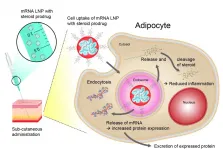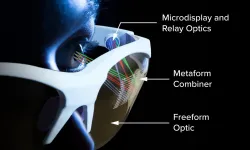How to manage osteoporosis in hematologic stem cell transplant recipients
IOF Cancer & Bone Disease Working Group summary and algorithm outlines main recommendations to maintain bone health in HSCT patients: includes guidance for bone assessment, management and treatment as well as dietary and lifestyle recommendations.
2021-05-03
(Press-News.org) Impaired bone health is among the most significant long-term consequences of hematopoietic stem cell transplantation (HSCT), a common therapy for patients with malignant and non-malignant haematological diseases.
To address this serious problem, the International Osteoporosis Foundation (IOF) expert Working Group on Cancer and Bone Disease has published a new Executive Summary of its authoritative state-of-the-art review. The review outlined the major factors affecting bone health in HSCT patients, and provided expert guidance for the monitoring, evaluation and treatment of bone loss in these patients. Published in the Journal of Bone Oncology, the Executive Summary now provides a helpful management algorithm and succinct key guidance based on the Working Group's expert opinion.
Professor René Rizzoli, Chair of the IOF Cancer and Bone Working Group and Emeritus Professor of Medicine at the University Hospitals of Geneva, Switzerland, stated:
"This concise summary aims to encourage and assist haematologists and oncologists in addressing osteoporosis and fracture prevention in their hematopoietic stem cell transplantation patients. The 'check list' includes bone mineral density examination, evaluation of clinical risk factors, and general dietary and physical activity measures, with appropriate application of osteoporosis pharmacotherapies in those who are found to be at increased high risk of fracture."
Professor Nicholas Harvey, Chair of the IOF Committee of Scientific Advisors and Professor of Rheumatology and Clinical Epidemiology at the MRC Lifecourse Epidemiology Unit, University of Southampton, UK added:
"Unfortunately, too many hematopoietic stem cell transplantation recipients are not being monitored and treated for bone fragility, despite the fact that poor bone health is a significant comorbidity post-HSCT. We therefore urge all physicians who care for HSCT recipients to take action to protect their patients' long-term bone health. It is important to keep in mind that fragility fractures can be severely debilitating, with resulting loss of physical independence and quality of life."
INFORMATION:
Further Reading:
Kendler, D., Body, J., Brandi, M. et al. , Osteoporosis management in hematologic stem cell transplant recipients: Executive summary, Journal of Bone Oncology, Vol. 28, 2021, 100361, ISSN 2212-1374, https://doi.org/10.1016/j.jbo.2021.100361.
Kendler, D., Body, J., Brandi, M. et al. Bone management in hematologic stem cell transplant recipients. Osteoporos Int 29, 2597-2610 (2018). https://doi.org/10.1007/s00198-018-4669-4
About IOF
The International Osteoporosis Foundation (IOF) is the world's largest nongovernmental organization dedicated to the prevention, diagnosis and treatment of osteoporosis and related musculoskeletal diseases. IOF members, including committees of scientific researchers as well as more than 260 patient, medical and research societies in 102 locations, work together to make fracture prevention and healthy mobility a worldwide heath care priority. http://www.iofbonehealth.org http://www.facebook.com/ @iofbonehealth
ELSE PRESS RELEASES FROM THIS DATE:
2021-05-03
Globally, tuberculosis is the most common bacterial infectious disease leading to death. The pathogen causing tuberculosis, Mycobacterium tuberculosis, has a number of peculiarities. One is that it is growing very slowly. While other typical pathogens, such as pneumococcal and pseudomonads, can already be identified by their growth in the microbiological laboratory in the first 72 hours, several weeks usually pass before tuberculosis bacteria grow in the lab. Thus it often takes one to two months before the efficacy of individual medicines can be tested.
However, these efficacy tests are essential for the effective treatment of multidrug-resistant tuberculosis (MDR-TB), which is becoming increasingly common. In these cases, the pathogen has become ...
2021-05-03
If not before, then certainly since the first messenger RNA (mRNA) vaccines to combat the SARS CoV2 virus were approved in Germany, mRNA has become a recognized term even outside scientific circles. What is less well known is that mRNA can be used to produce much more than just vaccines. Around 50 different procedures for the treatment of diseases including cancer are already being studied in clinical trials. Scientists from the pharmaceutical company AstraZeneca, with the support of neutron researchers from Forschungszentrum Jülich, have now discovered how the subcutaneous administration of mRNA can be improved. The goal is for chronically ill ...
2021-05-03
Scientists from the National Centre for radio Astrophysics of the Tata Institute of Fundamental Research (NCRA-TIFR) Pune used the upgraded Giant Metrewave Radio Telescope (uGMRT) to determine that AT 2018 cow, the first of a newly discovered class of cosmic explosions, has an extremely patchy environment. Sources like AT 2018cow release an enormous amount of energy, nonetheless fade extremely rapidly. This along with their extremely blue color has led to them being called FBOTs for Fast Blue Optical Transient. This is the first observational evidence of inhomogeneous emission from an FBOT. The origins of FBOTs are still under debate, but proposed models include explosion of a massive star, collision of an accreting neutron star and ...
2021-05-03
"Image" is everything in the $20 billion market for AR/VR glasses. Consumers are looking for glasses that are compact and easy to wear, delivering high-quality imagery with socially acceptable optics that don't look like "bug eyes."
University of Rochester researchers at the Institute of Optics have come up with a novel technology to deliver those attributes with maximum effect. In a paper in Science Advances, they describe imprinting freeform optics with a nanophotonic optical element called "a metasurface."
The metasurface is a veritable forest of tiny, silver, nanoscale structures on a thin metallic film that conforms, in this advance, to the freeform shape of ...
2021-05-03
According to Michael Twidale, professor in the School of Information Sciences at the University of Illinois Urbana-Champaign, bad usability can be an irritation for everyone but "especially awful" for the underprivileged. In "Everyone Everywhere: A Distributed and Embedded Paradigm for Usability," which was recently published in the Journal of the Association for Information Science and Technology (JASIST), Twidale and coauthors David M. Nichols (University of Waikato, New Zealand) and Christopher P. Lueg (Bern University of Applied Sciences, Switzerland) present a new paradigm to address the persistence of difficulties that people have ...
2021-05-03
(New York, NY) - May 3, 2021 - In advance of a wildfire season projected to be among the worst, the American Thoracic Society has released a report that calls for a unified federal response to wildfires that includes investment in research on smoke exposure and forecasting, health impacts of smoke, evaluation of interventions, and a clear and coordinated communication strategy to protect public health.
The report, Respiratory Impacts of Wildland Fire Smoke: Future Challenges and Policy Opportunities, was published online ahead of print in the Annals of the American Thoracic Society on May 3, 2021.
The report comes at a time when the U.S. is experiencing an increasing frequency of very large destructive wildfires, due to years ...
2021-05-03
Over 400 common disinfectants currently in use could be made safer for people and the environment and could better fight the COVID-19 virus with the simple application of UVC light, a new study from the University of Waterloo shows.
Benzalkonium chloride (BAK) is the most common active ingredient in many disinfectants regularly used in hospitals, households, and food processing plants to protect against a wide range of viruses and bacteria - including all strains of SARS-CoV-2, the coronavirus that causes COVID-19 - but its toxicity means that it can't be used in high concentrations. It also means that products containing BAK are harmful to humans ...
2021-05-03
LUGANO, Switzerland, 3 May 2021 - As breast cancer becomes a largely curable disease, with more than 70% of women surviving at least 10 years after diagnosis across most of Europe thanks to early detection and treatment, (1) the quality of life after cancer has become an important aspect of the patient journey - one that may be inadequately addressed with current standards of follow-up. A study presented at the ESMO Breast Cancer 2021 Virtual Congress (2) has shown that breast cancer survivors differ widely in the burden of symptoms they experience after the end of treatment and thereby revealed an unmet need for tailored approaches to follow-up care. (3)
Lead author Kelly de Ligt ...
2021-05-03
TORONTO - Scientists at the Krembil Brain Institute, part of University Health Network (UHN), in collaboration with colleagues at the Centre for Addiction and Mental Health (CAMH), have used precious and rare access to live human cortical tissue to identify functionally important features that make human neurons unique.
This experimental work is among the first of its kind on live human neurons and one of the largest studies of the diversity of human cortical pyramidal cells to date.
"The goal of this study was to understand what makes human brain cells 'human,' and how human neuron circuitry functions as it does," says Dr. Taufik Valiante, neurosurgeon, scientist at the Krembil Brain Institute at UHN and co-senior author on the paper.
"In our study, we wanted ...
2021-05-03
Customised medicines could one day be manufactured to patients' individual needs, with University of East Anglia (UEA) researchers investigating technology to 3D 'print' pills.
The team, including Dr Andy Gleadall and Prof Richard Bibb at Loughborough University, identified a new additive manufacturing method to allow the 3D printing of medicine in highly porous structures, which can be used to regulate the rate of drug release from the medicine to the body when taken orally.
Dr Sheng Qi, a Reader in Pharmaceutics at UEA's School of Pharmacy, led the research. The project findings, 'Effects of porosity on drug release kinetics of swellable and erodible porous pharmaceutical solid dosage forms ...
LAST 30 PRESS RELEASES:
[Press-News.org] How to manage osteoporosis in hematologic stem cell transplant recipients
IOF Cancer & Bone Disease Working Group summary and algorithm outlines main recommendations to maintain bone health in HSCT patients: includes guidance for bone assessment, management and treatment as well as dietary and lifestyle recommendations.





